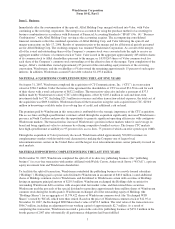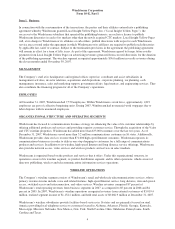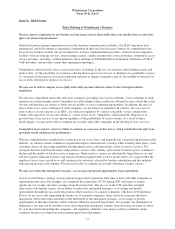Windstream 2007 Annual Report Download - page 54
Download and view the complete annual report
Please find page 54 of the 2007 Windstream annual report below. You can navigate through the pages in the report by either clicking on the pages listed below, or by using the keyword search tool below to find specific information within the annual report.
Windstream Corporation
Form 10-K, Part I
Item 1. Business
be deregulated. Price cap regulation better aligns the Company’s continued efforts to improve its cost structure because
rates for interstate wholesale services are not required to be periodically adjusted based on the Company’s cost
structure. Many of the Company’s larger customers purchasing the services that are the subject of this petition filed
comments with the FCC in favor of the petition. No parties filed in opposition. The FCC is currently considering the
petition, and the Company expects the petition to be approved prior to July 1, 2008.
Inter-carrier Compensation
The Company’s local exchange subsidiaries currently receive compensation from other telecommunications providers,
including long distance companies, for origination and termination of interexchange traffic through network access
charges that are established in accordance with state and federal laws.
In April 2001, the FCC released a notice of proposed rulemaking addressing inter-carrier compensation. Under this
rulemaking, the FCC proposed a “bill and keep” compensation methodology under which each telecommunications
carrier would be required to recover all of its costs to originate and terminate telecommunications traffic from its
end-user customers rather than charging other carriers. The proposed “bill and keep” method would significantly
overhaul the existing rules governing inter-carrier compensation. On March 3, 2005, the FCC released a further notice
of proposed rulemaking addressing inter-carrier compensation. Under this proposed rulemaking, the FCC requested
comment on several alternative inter-carrier compensation proposals, including “bill and keep.”
In July 2006 the National Association of Regulatory Utility Commissioners’ Task Force on Inter-carrier Compensation
filed an industry-sponsored reform plan called the “Missoula Plan” which proposes a comprehensive reform to inter-
carrier compensation that is different than “bill and keep”. In summary, the Missoula plan seeks to reduce rates carriers
charge one another to originate and terminate calls between networks, increase end user retail rates and create
additional funding through an expanded universal service program. The Company supports the proposed Missoula plan
because the plan would bring stability and certainty to the marketplace and encourage continued network investment
for the benefit of customers and carriers.
The FCC has received other proposals to reform inter-carrier compensation mechanisms. The outcome of these
proceedings is likely to change the way the Company receives compensation from, and remits compensation to, other
carriers and its end user customers as well as the federal universal service fund. Until these proceedings conclude and
any changes to the existing rules are established the Company cannot estimate the impact of any changes on its ILEC
revenues or expenses or when such changes would occur.
Additional inter-carrier compensation issues pertaining to VoIP providers are discussed in the “VoIP Telephony”
section below.
Universal Service
The federal universal service program is under legislative, regulatory and industry scrutiny as a result of the growth in
the fund and structural changes within the telecommunications industry. The primary structural change is the increase
in the number of Eligible Telecommunications Carriers (“ETCs”) receiving money from the Universal Service Fund
(“USF”). There are several FCC proceedings underway that are likely to change the way the universal service
programs are funded and the way universal service funds are disbursed to program recipients. The specific proceedings
are discussed below.
On May 1, 2007, the Federal/State Joint Board on Universal Service (the “Joint Board”) released a recommended
decision for consideration by the FCC to impose an interim cap on the amount of high-cost support that competitive
ETCs may receive. The interim cap would be determined on a state level based on the average level of support
distributed to competitive ETCs in 2006. The FCC will determine whether or not to adopt the recommended interim
cap. The Company does not expect material changes to its existing federal universal service support as a result of the
Joint Board’s recommendation and potential adoption by the FCC.
8
























